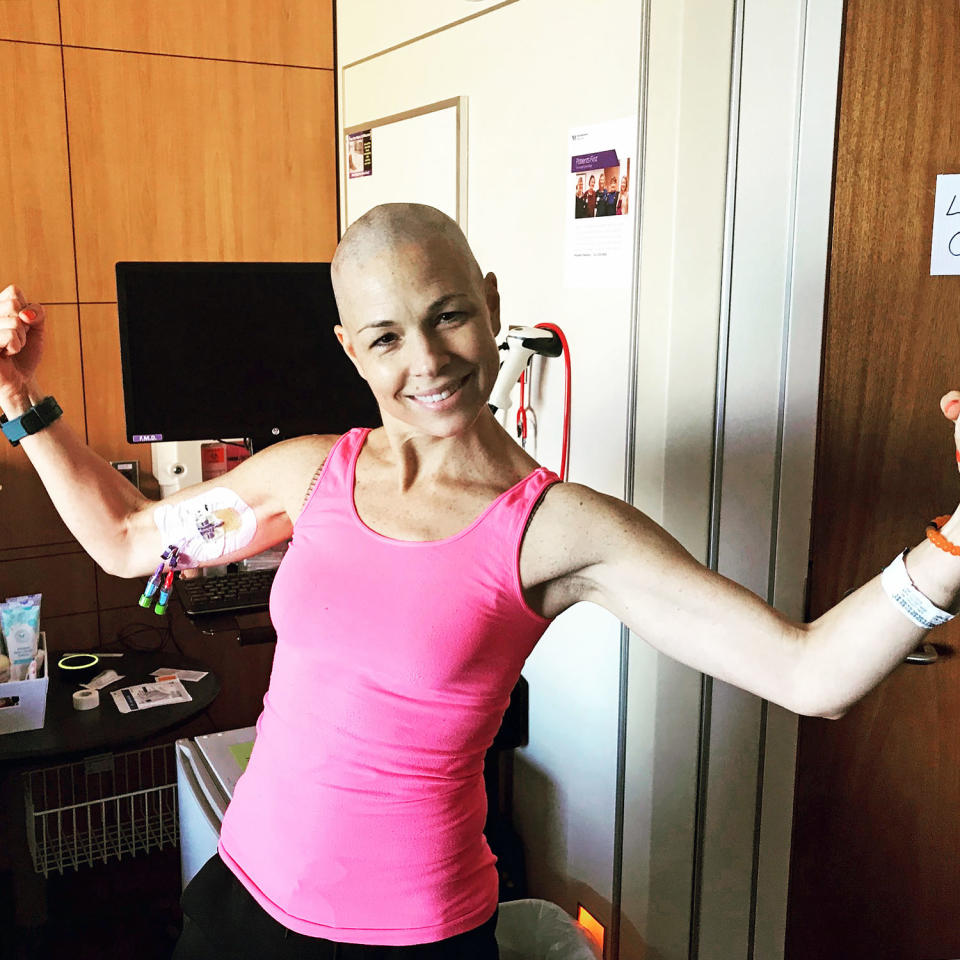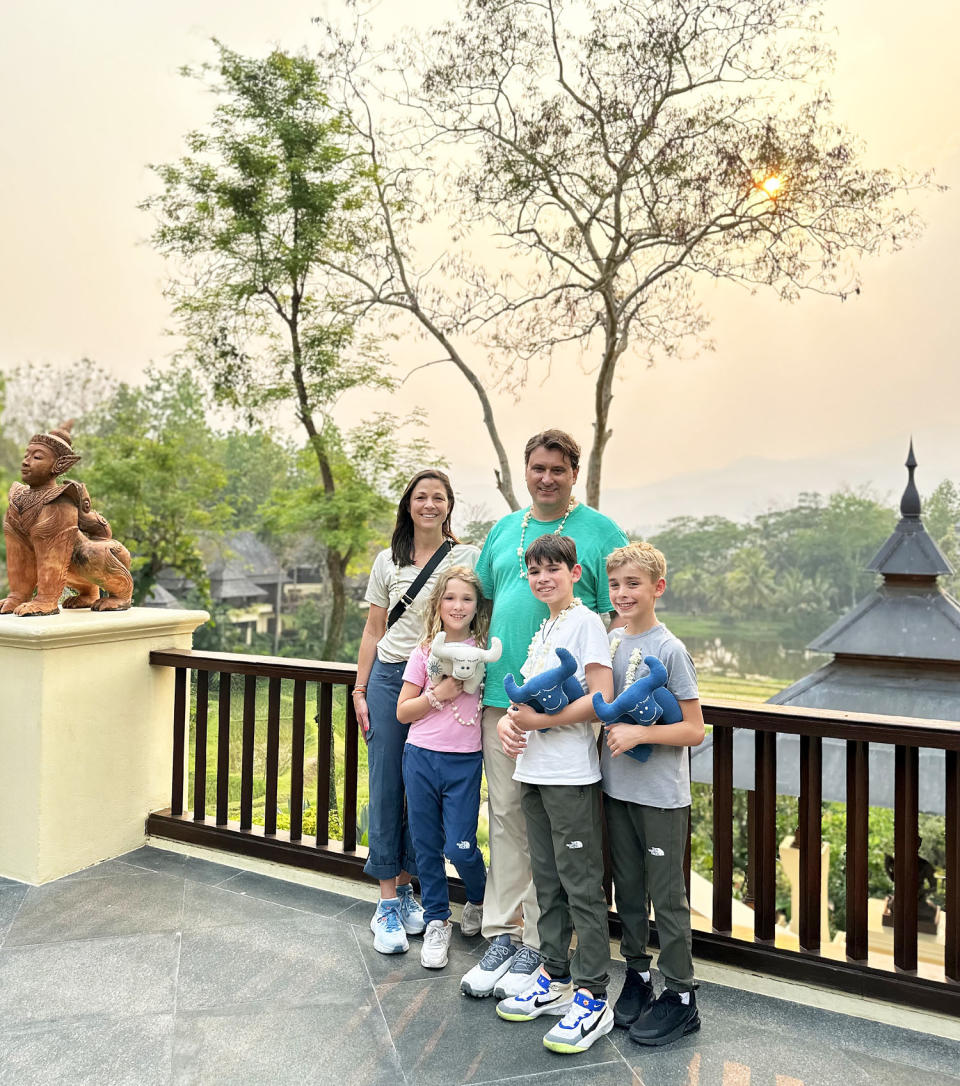In 2018, Laura Hendricks, then 40, took her three children to the pediatrician after they developed a cold. As she described their symptoms, the doctor interrupted her.
“She really stopped me middle of the sentence and said, ‘What’s going on with you?’ and I was really taken aback that she was focusing on me, rather than the kids,” Hendricks, 46, of the Chicago area tells TODAY.com. “I said, ‘Well, I’m really tired and I think I’m coming down with what they’re coming down with.’”
The pediatrician insisted that Hendricks make an appointment with her own doctor, and she did. Soon after, Hendricks learned why she looked ill: She had acute myeloid leukemia (AML).
“It’s so aggressive,” she says. “(Surviving cancer) was truly one of the hardest things I’ve ever done.”
A pediatrician spots a problem
Hendricks had just returned from a London business trip and discovered that her three children, then 5, 4 and 2, were sick. So, she made a pediatrician’s appointment. During the visit, the doctor became concerned about Hendrick’s health. At first, Hendricks explained she was tired. But the doctor continued pushing.
“She challenged me again and said, ‘No, your coloring doesn’t look right. Let me see your hands,’” Hendricks recalls. “She looked at them and said, ‘I think you should have some bloodwork done.”
Hendricks’ mom went with her to the pediatrician and also insisted that Hendricks schedule a doctor’s visit.

“She said, ‘I’m not leaving until you make your appointment that the pediatrician wanted you to make because I think something might be wrong,’” Hendricks says.
Like a good daughter, she made the appointment. Her doctor conducted bloodwork, and Hendricks felt relieved when she received an automated email saying her results were normal.
But the next day, she realized she missed three phone calls from her doctor. The voicemails confused her at first.
“The last one was from that morning saying, ‘You need to go to the ER,’” Hendricks says. “I asked my doctor, ‘What is this about?’ and she said, ‘You need a blood transfusion.’”
A surprised Hendricks asked why, and her doctor explained that she could have anemia or “something else,” Hendricks recalls. On the way to the hospital, she kept receiving automated emails with test results. One noted a problem with her white blood cell count, and Hendricks remembers thinking that could be a sign of cancer, but she wasn’t confident in her assessment.
At the hospital, she learned what was wrong.
“They said, ‘You have leukemia, and you have an aggressive form of it called AML,” she says. “The whole world changed.”
Acute Myeloid Leukemia
According to the National Cancer Institute, acute myeloid leukemia happens when the bone marrow produces too many abnormal blood cells. It is “the most common type of acute leukemia in adults,” the institute notes. That said, it’s rare, occurring in 4 out of 100,000 adults a year, often in people over 60, per the Cleveland Clinic. Acute means it has a fast onset and is considered aggressive.
According to the Cleveland Clinic, symptoms can include:
-
Pale skin
-
Feeling run down or like you have a cold or flu
-
Feeling dizzy
-
Bruising easily
-
Bleeding gums
-
Frequent nosebleeds
-
Exhaustion
-
Fever
-
Headache
-
Sweating at night
-
Feeling cold
-
Frequent infections
-
Weight loss for no reason
-
Weakness
-
Loss of appetite
-
Shortness of breath
-
Inflamed lymph nodes
-
Red spots on skin, known as petechia
-
Open sores or wounds
Treatment can include chemotherapy, monoclonal antibodies and stem cell transplants. When patients reach remission, they have normal blood counts, and there are no cancer cells in the bone marrow anymore, according to the Cleveland Clinic.
Surviving
For seven months, Hendricks stayed in the hospital to undergo treatment.
“Because it’s so aggressive, you’re admitted to the hospital that day to start treatment as quickly as possible,” she says. “That was extremely overwhelming.”
Spending long days in the hospital meant she had a lot of time to worry about the future.
“(I) had all those feelings that probably every mom or parent can relate to having — a complete and utter fear of not being able to be their mom,” she says. “What if I don’t see them growing up? What if I don’t see them go to high school and get married? What if I am not going to be here?”
The first month, she underwent intense chemotherapy to treat her cancer, which also “wipes out your entire immune system,” Hendricks recalls. When her immune system strengthened after about seven weeks, she went home briefly but had to return for treatment again. She eventually received a stem cell transplant.
The family asked for permission for her children to visit, and that kept her motivated during treatment.
“I had that mentality that I was going to be a survivor,” she says. “What rooted me to survival … was my children and my husband and my family. Truly, I wanted to be their mom for the rest of their lives.”
After her stem cell transplant, Hendricks went into remission and has been cancer free for the past five years.
“I’m one of the lucky ones,” she says. “I have not relapsed.”
Helping others survive
About 15 months after her diagnosis, Hendricks felt like she was “getting out of the woods,” she recalls. Her energy levels returned, and she could keep up with her children again. It’s also when she started to face the trauma of what’d she experienced. Her husband, Brock, helped her start to navigate life as a survivor.
“He was really the first one to start to identify those changes he was seeing in me and wanting to work toward how we (could) help me,” she says.
They focused on how she could get more and better quality sleep, practice gratitude, eat healthy and address some of those tough emotions she was facing as a survivor, like guilt.
Soon, Hendricks realized that “some of these habits that I was focusing on in small doses (were) helping me feel a lot more positive and excited and upbeat about my survivorship,” she says.
She and her husband wondered if some of these small, daily changes that worked for her could also help other cancer survivors. Hendricks then began to reflect on all the privileges in her life that were making survivorship easier for her, like access to therapy and child care, which many other survivors don’t have.
So, she and Brock founded Luminaries, which supports cancer survivors with self-care kits and teaching them other ways to thrive.
“We really wanted to help support survivors,” Hendricks recalls. “That’s where we saw the (biggest) of lack of resources.”

For example, Hendricks says it’s common for cancer patients to live far away from where they received treatment. So when they’re done with it, they return home to an “island,” where there may not be much medical support, she explains.
“Everyone should have access to a world-class, science-backed program that helps guide you in survivorship in the same way you are guided during treatment,” Hendricks says. “One of the hardest things in survivorship is how do you get up every day and take the next step forward on your own?”
The Luminaries self-care kits are delivered to survivors’ homes with the goal of helping them build healthy habits to better take on the next part of their lives. Take sleep: Many cancer patients struggle to get good sleep during treatment, and they’ll need even more sleep as survivors, Hendricks says. The sleep kit provides an eye mask and education on techniques, such as meditation or yoga nidra, to encourage more restful sleep.
Hendricks says Luminaries provides people with support after cancer that many just do not have.
“I’m so grateful every day for the chance I was given to still be here, to be a mom, to be a sister, to be a wife, to be a daughter, to be a friend,” she says. “I know how hard my survivorship journey was with those advantages. All I want to do is make survivorship easier for other people.”
This article was originally published on TODAY.com


